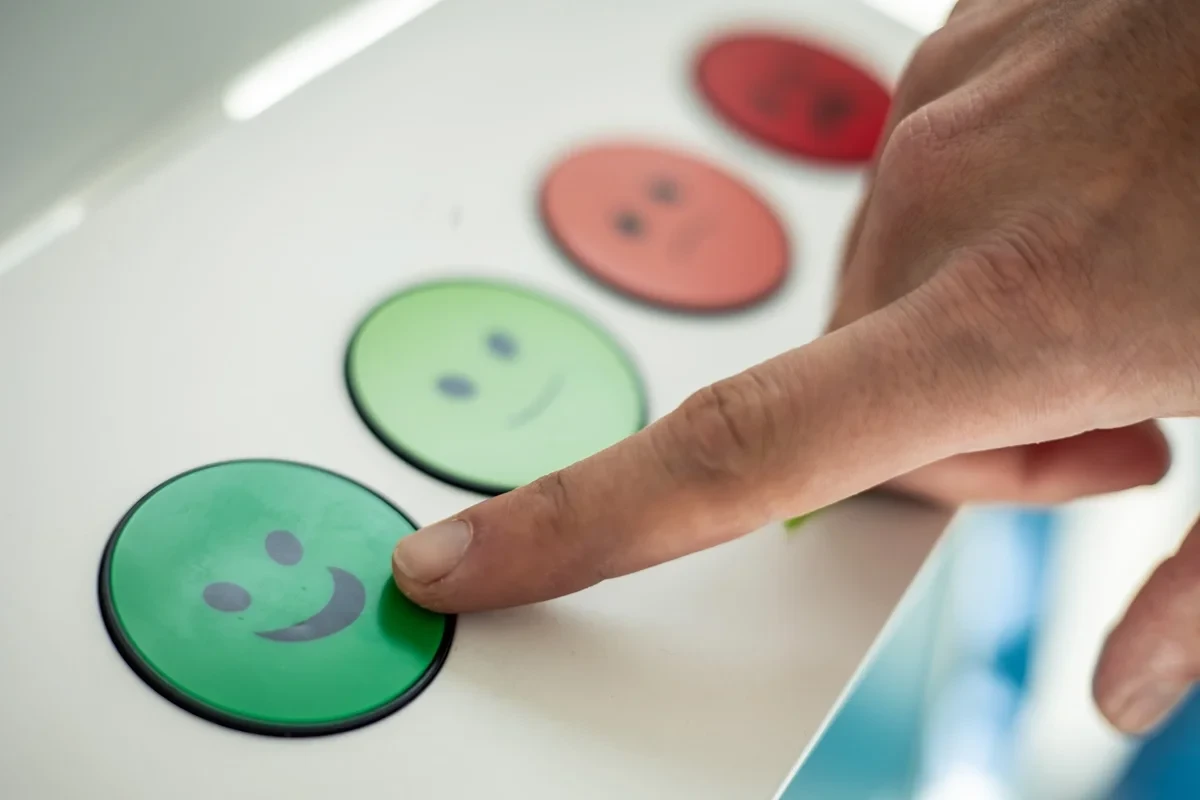Understanding how much effort you ask your customers to put in when interacting with your business is key to making them happy and keeping them loyal. When you measure this effort, you can spot the tricky parts that might push customers away or the smooth spots that keep them coming back. By focusing on making things easier, you create better experiences that build strong, lasting relationships.
To help you navigate this important metric, we’ll explore everything you need to know about customer Effort Score (CES), including why it matters, how to measure it accurately, and how to use the feedback to enhance customer happiness and loyalty. Keep reading!

What is the Customer Effort Score (CES)?
Customer Effort Score, or CES, is a simple way to find out how much work your customers have to do to get help or complete a task with your company. It measures how easy or hard it is for them to solve a problem, make a purchase, or get information.
Other key customer experience metrics include Net Promoter Score (NPS) and Customer Satisfaction Score (CSAT). While CES focuses on the effort required by customers, Net Promoter Score measures customer loyalty by asking how likely customers are to recommend your company, and Customer Satisfaction Score gauges overall satisfaction with a specific interaction. Together, these metrics provide a comprehensive view of customer experience.
Usually, you ask your customers to rate their experience on a scale—like from 1 to 5 or 1 to 7—where a higher score means things were easy, and a lower score means they had to put in more effort. Typical customer effort score questions in surveys include prompts like “How easy was it to resolve your issue today?” or “The company made it easy for me to handle my request.” This score helps you see which parts of your service make life easy for your customers and which parts might be causing frustration.

Why is Customer Effort Score Important?
Your Customer Effort Score (CES) matters a lot because it shows how easy or hard it is for your customers to get what they need from you. Effort scores are a key part of customer service metrics, helping you identify pain points and improve service. When customers don’t have to work hard, they’re happier and more likely to stick around. Here’s why it’s so important for you:
- 94% of customers say they’ll buy again after having a low-effort experience with a company.
- Making things easier for your customers helps them see your business in a positive light.
- When customers don’t have to struggle, your customer service costs go down.
- Low effort interactions intend to increase customer loyalty and reduce customer churn.
- Companies that focus on reducing customer effort often see improved future purchase behavior and higher customer retention.
CES helps you spot the smooth parts of your service and the tricky spots that might be causing frustration. Since the ease of experience is one of the biggest drivers of customer loyalty, lowering effort means more customers coming back and staying loyal.
By keeping an eye on your CES and working to improve it, you’re not just tracking a number—you’re building stronger relationships, encouraging customers to stay engaged, and making sure they’re happy with every interaction. Reducing high effort experiences helps build customer loyalty and ensures you meet or exceed customer expectations.
How to Calculate Customer Effort Score
Customer Effort Score (CES) is typically measured through surveys where customers rate their experience on a scale, commonly ranging from 1 to 5 or 1 to 7. The scale is designed to assess how much effort customers had to put forth to accomplish a specific task, such as resolving an issue, making a purchase, or obtaining information.
In this scoring system:
- Higher scores generally indicate lower effort, meaning the customer found the interaction easy.
- Conversely, lower scores reflect higher effort, indicating the customer faced difficulties.
To calculate the CES, you sum all the customer effort ratings collected and then divide that total by the number of survey respondents. This calculation yields your CES score, which represents the overall ease or difficulty customers experienced. Using a customer effort score benchmark allows you to compare your CES score over time or against industry standards, helping you interpret what constitutes a good score.
For example, if out of 100 respondents, 65 rate their experience as 5, 6, or 7 on a 7-point scale (indicating a low-effort interaction), the CES can be expressed as 65%. This percentage reflects the proportion of customers who found the interaction easy or very easy.

Types of Customer Effort Score Surveys
There are various types of CES surveys, each designed to capture customer effort differently. Creating an effective customer effort score survey is crucial, and using a well-structured CES survey template helps ensure clarity and consistency. Many CES surveys companies use standardized templates that include specific customer effort score questions to accurately measure the ease of customer interactions. The most common methods used are:
- Numbered scales
- Likert scales
- Emoticon ratings
- Open-ended questions
Numbered Scale CES Surveys
With numbered scale CES surveys, you ask your customers to rate their experience using a simple number scale, usually from 1 to 5 or 1 to 7. Numbered scale surveys are a popular way to measure customer effort score, as they provide a clear and quantifiable method for tracking how much effort customers feel they have to put in. Higher numbers mean the experience was easy and required little effort. These surveys are straightforward and quick to answer, so your customers will likely respond more often. For example, you might ask, “Was it easy to pause your subscription?” or “Did you find pausing your subscription simple?”
Likert Scale CES Surveys
Likert scales let your customers tell you how much they agree or disagree with a statement, like “The checkout process was easy to navigate.” They can pick from options like strongly agree, agree, neutral, disagree, or strongly disagree. This gives you a clearer picture of how your customers really feel, helping you get detailed feedback to improve their experience.
Emoticon Ratings CES Surveys
Emoticon ratings make giving feedback quick and fun. Instead of numbers or words, your customers pick a face that shows how they feel—like a happy smiley or a frown. It’s an easy way for them to tell you if something was simple or frustrating without reading long questions. You might ask, “How easy was it to use our service?” and let them choose the emoji that fits best.
Open-ended CES Questions
Open-ended questions give your customers a chance to share their story in their own words. You can ask things like, “What challenges did you face during this process?” or “How can we make this easier for you?” Not everyone will answer, but those who do often share valuable insights that help you spot problems you might not have noticed. Open-ended questions also encourage customers to provide more detailed feedback, leading to deeper insights. This kind of feedback is pure gold for making real improvements your customers will appreciate.
When to Use Customer Effort Score Surveys
Timing is crucial when administering Customer Effort Score (CES) surveys to ensure you capture accurate and actionable feedback. The goal is to gather insights while the customer’s experience is fresh in their mind, which helps in obtaining precise reflections of their interaction with your company.
- Immediately after key interactions: CES surveys should be sent promptly following important customer interactions such as purchases, customer service calls, onboarding sessions, or technical support engagements. It is essential to send the CES survey immediately after a customer support interaction or service interaction to capture timely and reliable feedback.
- Post-purchase: Right after a customer completes a purchase, sending a CES survey helps measure customer effort during customer service interactions and evaluate how smooth and effortless the buying process was. This includes assessing factors like ease of navigation, payment processing, and confirmation communications.
- After customer service touchpoints: Whether customers have contacted your support team via phone, email, chat, or social media, deploying CES surveys immediately after customer support interactions across multiple departments ensures comprehensive feedback. This approach helps identify friction points in customer service interactions and service interaction, allowing you to improve processes and enhance the overall customer experience.

Essential Tips to Improve Your CES
Here are six practical and effective tips designed to help you improve your Customer Effort Score (CES). Use this list as a roadmap to reduce customer effort and create low effort experiences, making interactions smoother and more efficient for your customers.
These tips will also help you address customer frustration and better meet customer needs, ensuring your support is both responsive and effective.
1. Simplify processes
Make your website or app easy to use by cutting out extra steps and confusing parts, streamlining workflows by removing unnecessary clicks, forms, or options that might overwhelm users. Organize content logically with clear labels and intuitive navigation paths, then test each step of the process to ensure it flows smoothly and efficiently from start to finish.
2. Enhance customer service
Train your customer service reps thoroughly on product knowledge, common issues, and effective communication techniques, while equipping your team with up-to-date tools and resources to access information quickly. Establish clear protocols for handling different types of inquiries and encourage empathy and patience during interactions, providing ongoing coaching and feedback to maintain high service standards.
3. Optimize user interface
Conduct regular usability testing to identify confusing elements or bottlenecks in your website, app, or software, then simplify layouts by reducing clutter and focusing on essential features. Improve accessibility by ensuring compatibility with various devices and assistive technologies, and update design elements to maintain consistency and clarity across all pages and screens.
4. Implement proactive communication
Develop a schedule for sending timely updates, tips, and reminders to customers, using multiple channels such as email, SMS, or in-app notifications to reach users effectively. Create content that anticipates common questions or issues and addresses them upfront, while monitoring customer behavior to trigger communications based on specific actions or milestones.
5. Expand self-service options
Build comprehensive FAQs, how-to guides, and troubleshooting resources that cover a wide range of topics, complemented by interactive tools like chatbots or virtual assistants to guide customers through common problems. Ensure your self-service portal is easy to search and navigate, and regularly update content to reflect new products, features, or known issues.
6. Monitor and act on CES feedback
Set up systems to collect customer feedback through a customer effort score survey promptly after customer interactions and analyze data to detect trends, recurring problems, or areas needing improvement. In the analysis step, review CES data for actionable insights. Share insights with relevant teams to inform process changes or training needs, then implement changes based on feedback and track their impact over time to ensure continuous improvement.
How Can CES Improve Customer Experience?
Acting on feedback by resolving highlighted issues is vital for maintaining customer trust and enhancing customer satisfaction. CES scores provide actionable insights by identifying specific customer service touchpoints and interaction points that may require additional focus for improvement. By combining customer effort scores with customer satisfaction scores, organizations gain a more comprehensive view of the customer’s experience, enabling them to better understand and improve overall satisfaction and loyalty.
Building on these insights, key strategies to improve your customer support team and overall customer experience include:
- Equipping customer support agents with adequate tools to enable more efficient resolution of customer issues, thereby lowering customer effort.
- Investing in training your customer service team to enhance service quality based on customer insights gathered from CES surveys and other customer experience metrics. Consider using other customer service metrics, such as NPS and CSAT, alongside CES to gain a broader understanding and improve outcomes.
- Streamlining onboarding processes to help customers reach their goals more quickly and easily, as recommended by service leaders. Additionally, implementing effective customer service solutions and self-service tools can further enhance the overall support experience and reduce high effort service interactions.
Reducing customer effort not only improves the customer’s experience but also encourages repeat customer behavior, which drives long-term growth and loyalty.

Boost Customer Satisfaction with Reliable Outsourcing Solutions
Choosing the right service provider is key to giving your customers great experiences and keeping your Customer Effort Score low. A reliable partner helps make things easier for your customers, cutting down their frustration and effort. Outsourcing can improve customer service altogether by integrating product quality, pricing, and support into a seamless experience. This means happier customers who keep coming back.
At Outsource Philippines, we focus on delivering top-notch customer support tailored just for your business. Our friendly and skilled customer service reps know how to handle different departments with care and professionalism, making sure every customer interaction feels smooth and pleasant. When you team up with us, you get access to smart tools, dedicated support teams, and a promise to go above and beyond to meet your customers’ needs.
Let Outsource Philippines be your trusted partner in creating effortless customer experiences that help your business grow and build loyal customers.







